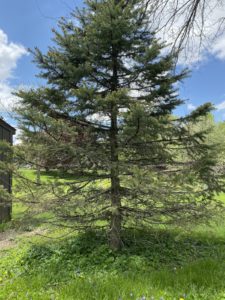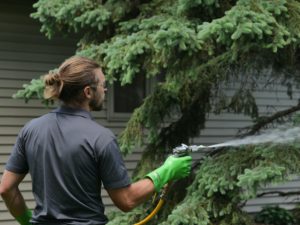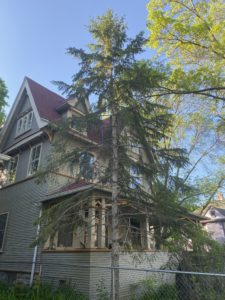What Is Rhizosphaera?
 Rhizosphaera needle cast is caused by the fungus, Rhizosphaera kalkhoffii. The disease causes death and casting (dropping) of needles in Spruces. It most commonly affects Colorado Blue Spruce but can infect other Spruce species.
Rhizosphaera needle cast is caused by the fungus, Rhizosphaera kalkhoffii. The disease causes death and casting (dropping) of needles in Spruces. It most commonly affects Colorado Blue Spruce but can infect other Spruce species.
Needle Cast on Spruce trees is generally first evident on the innermost needles in the lower canopy. Infected needles become spotted, some turning yellow and some brown. If allowed to persist it can cause severe needle loss, death of individual branches and eventually to the tree.
Don’t wait to get a professional diagnosis. Call Eco Tree Company today for a tailored approach on how to treat needle cast disease.
Life Cycle
Rhizosphaera kalkhoffii overwinters in infected needles, on the tree or ground and are released from the infected needles in the spring. Spores are dispersed by wind and splashing rainwater and infect newly emerging needles with a soft cuticle as well as mature needles. Once the needles are infected, symptoms may take 12 months or longer to become visible. Prolonged wetness, especially in spring, is your spruces nightmare scenario!
Needle Cast Disease Treatment
 Infections should be sprayed with a proper contact fungicide registered for use against this disease. Treatment occurs when needles are half-elongated and again when fully elongated. A minimum of 3 years of treatment is recommended because of the organism’s life cycle. These treatments will not cure existing infections but will prevent additional infections.
Infections should be sprayed with a proper contact fungicide registered for use against this disease. Treatment occurs when needles are half-elongated and again when fully elongated. A minimum of 3 years of treatment is recommended because of the organism’s life cycle. These treatments will not cure existing infections but will prevent additional infections.
ECO Tree Company only uses the most effective and environmentally sound treatments applied by our certified arborists local to the Madison, WI greater area.
Other Rhizosphaera Needle Cast Treatment Strategies

- Select healthy plants and avoid planting Colorado Blue Spruce: Concolour Fir Is Our favorite alternative!
- Remove infected needles and branches: Prune out diseased branches and rake up fallen needles. Burn or remove the debris. Disinfect pruning tools between cuts.
- Avoid excessive watering: This can promote infection. Spores require moisture to germinate and infect.
- Improve air circulation to allow needles to dry more quickly: Maintain open spacing when planting or by mowing grass or brush. This promotes increased airflow, which is less favorable for infection and disease development.
During your consultation, our team of tree care experts will advise which approach is suitable on a case-by-case basis.
